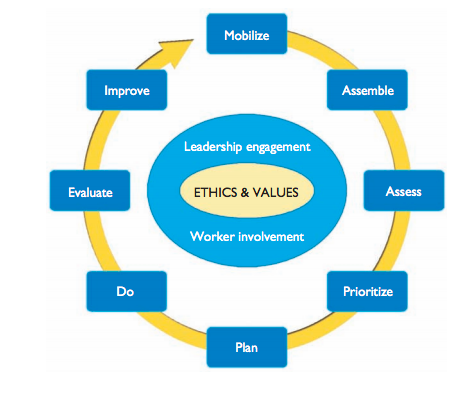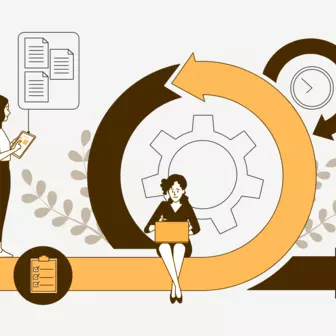A recent survey by Synopsys reveals that almost 70% of corporate organizations are either contributing to or participating in open-source projects. Gaining attention in the web development industry, open source is more about proactively engaging and promoting communities around shared challenges. More than being just about publishing codes, it’s about supporting the abilities of developers to contribute. Open source can operate without any policy guidance or a large organizational structure.
70% of corporate organisations are either contributing to or participating in open-source projects.

Organisations trading in open source communities have a close and connected network that calls for an engaging outlook to keep the ideas floating and new developments to flourish. There are two kinds of approaches that can be executed in order to achieve harmony among the open source communities and to empower businesses along with it. Let’s take them one by one.
External Engagement
Along with open source tools, databases, platforms, and languages, organizations are advised to have an open structure that allows flexibility to both the internal and the external sources that affect the workings of the institution. Here are five best practices for pursuing open source in any organization:
Stakeholders
It’s an established fact that open source is where everyone contributes, including all types of stakeholders, on both sides of the firewall. Here’s a brief list of personas who would be likely interested in the project:
- Non-technical, non-user stakeholders
- Potential users
- Veteran (or curious) users
- Subject matter experts
- Technical users
- Potential/Active developers
Encourage Dialogue
To be a part of the open source community, you must invite contributors. Providing them with the necessary tools to collaborate, both social and technical, connecting subject matter and technical experts can encourage a healthy and connected environment which is open for dialogue.
Minimize Friction
Friction is the time taken by a potential contributor from deciding that they will contribute to actually contributing in the open source community. Minimizing friction becomes essential to encourage the first time contributors and to turn them into long-term collaborators. This can be done by improving documentation and scripting common tasks by the maintainer. This means taking a closer look at the contribution flow from discovery to merge and deployment and foretelling the potential contributor’s requirements at each step.
Decentralize
The success of an open source organization rests on two things, decentralization and informality, which large organization tends to miss out on. With strict company policies and focus on protocols, the essence of open source seems to be in a blur. The process should be exposed through public discussions and participation as a member of the community, and not of the organization only.
Encourage Contributors
As the right to contribute is assumed in any open source structure, it becomes important to lay down some instructions on how to do so. These instructions can include what to expect from the project maintainers, and the technical requirements to run the projects locally. You can also provide constructive support, praise, and feedback with every contribution made by the developers.
Internal Collaboration

In any open source community, the first lesson is to learn to collaborate. More than just publishing, open source is more like a philosophy of modern approach to software development. An organisation can’t have a closed source culture behind the firewall and expect to foster an open source culture publicly. Here are five best practices for tracking internal collaborations on open source in an organization:
Promoting Open Culture
When embarking on organization’s first open source project, one is likely to be using open source as a tool for organizational change. The true confrontation is faced to decipher if you can foster the necessary internal culture to support your open source project externally. It is always believed that the way an organization works internally mirrors how it works externally, and if that workflow is closed, hostile or untrusting, you’ll likely to have trouble embracing the open source culture or grow rapidly. Thus, before embarking on any project, spend some time improving the internal workflows and rules of collaborations.
Taking Small Steps
While making the first move in open source, it is always advised to keep it small and inconsequential instead of betting big with a flagship initiative. One can start experimenting by collaborating openly, but in private, within the safety of your team or organization. Later, you can get other stakeholders involved, legal, procurement, ethics, and everything else. The goal should be to ensure sync among the organization while going through the motions of open source, with a bit of help from training wheels.
Minimizing Instability
While Open source is about growing a community, we often tend to ignore the contributors who are outside and only think about project stakeholders within the organization. However, keeping those outside the firewall on equal footing, in terms of leveling information and autonomy to improve the project , as those inside the firewall becomes important for the balance of information.
Embracing constraints
Bound by certain workflow limitations in an open source, you must embrace the constraints of the contributors. This can be done by adopting modern, asynchronous tools, that will improve the workflow which should be professional, but not formal. Organizations should go for social and cultural constraints to technical or administrative constraints that are unable to adapt to changing circumstances.
Working for a cause
To garner a strong presence in the open source community, one should provide the developers with a cause to work towards, exciting problems for them to solve and a vision to move in a defined direction. Just a few lines of codes expressing your idea and getting started with the documentation is enough to maintain a workflow. Working in the open source will make you write better, more modular code, allowing you to get early feedback from stakeholders, both internal and external.
The Future is Open
The idea of joining something with a bigger potential reach and working on an exciting project keeps the developers frequently motivated.
Increasingly, enterprises are providing compatible and productive environments for open source collaborations across institutions. They are trying to merge with smaller corporations or individuals to let them contribute and channel their expertise alongside large enterprises, start-ups, and their faculty. With the open source AI world thriving, it aims to yield more benefits in the future to individuals and not just corporations.
Organizations’ solely based on open source or in close collaborations with open source projects recognize the driving force being the ability to co-create faster and learn together. For instance, IBM’s proposed Red Hat acquisition, Microsoft’s acquisition of GitHub, and Google’s acquisition of Kaggle reflect the growing importance of code, content, and community. Where code is about open source software with test cases, content includes open data, documentation, and tutorials, and community is about the people in different roles and organizations. These three pillars democratize development in the open enterprise in a way that ropes both technical and non-technical (developers, software engineers, data scientists, subject matter experts (SMEs), marketing professionals, and communications) to participate in new ways and accelerate value co-creation by people with their own AI.
The idea of joining something with a bigger potential reach and working on an exciting project keeps the developers frequently motivated. When they are seeking to create apps that serve manifold objectives and institutions around the world, it is empowering to have inclusive teams that build better solutions.
What’s Next?
As we are still figuring out how employees having added individual freedom and responsibility will unfold in the future, there is no denying that open source communities are a core part of corporate strategies that actively seek to engage employees, customers, partners, competitors, and others in the ecosystem to co-create service innovations as a community.
Developers are now known to be coming out as the visible makers in a software-bitten world and companies are proactively engaging external developers to support their ability to contribute. Thus, open source is seen to be growing with the non-traditional industries like shipping, fashion, banking and manufacturing which are transforming into software companies.
We at OpenSense Labs hold a strong belief in promoting open source associations that foster a long-lasting relationship with our contributors and collaborators. Contact us [email protected] or visit our website to know more.
Subscribe
Related Blogs
Exploring Drupal's Single Directory Components: A Game-Changer for Developers

Web development thrives on efficiency and organisation, and Drupal, our favourite CMS, is here to amp that up with its…
7 Quick Steps to Create API Documentation Using Postman

If you work with API , you are likely already familiar with Postman, the beloved REST Client trusted by countless…
What is Product Engineering Life Cycle?

Imagine constructing a house without a blueprint or a set of plans. It will be challenging to estimate the cost and labor…




